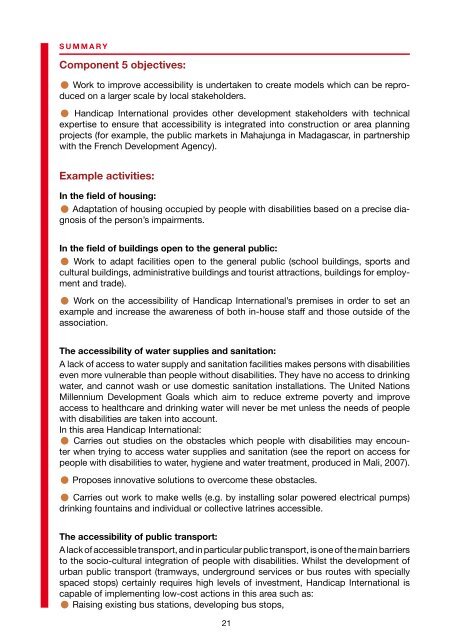Accessibility - Handicap International
Accessibility - Handicap International
Accessibility - Handicap International
Create successful ePaper yourself
Turn your PDF publications into a flip-book with our unique Google optimized e-Paper software.
S U M M A R Y<br />
Component 5 objectives:<br />
•<br />
•<br />
Work to improve accessibility is undertaken to create models which can be reproduced<br />
on a larger scale by local stakeholders.<br />
<strong>Handicap</strong> <strong>International</strong> provides other development stakeholders with technical<br />
expertise to ensure that accessibility is integrated into construction or area planning<br />
projects (for example, the public markets in Mahajunga in Madagascar, in partnership<br />
with the French Development Agency).<br />
Example activities:<br />
In the field of housing:<br />
•<br />
Adaptation of housing occupied by people with disabilities based on a precise diagnosis<br />
of the person’s impairments.<br />
In the field of buildings open to the general public:<br />
•<br />
Work to adapt facilities open to the general public (school buildings, sports and<br />
cultural buildings, administrative buildings and tourist attractions, buildings for employment<br />
and trade).<br />
•<br />
Work on the accessibility of <strong>Handicap</strong> <strong>International</strong>’s premises in order to set an<br />
example and increase the awareness of both in-house staff and those outside of the<br />
association.<br />
The accessibility of water supplies and sanitation:<br />
A lack of access to water supply and sanitation facilities makes persons with disabilities<br />
even more vulnerable than people without disabilities. They have no access to drinking<br />
water, and cannot wash or use domestic sanitation installations. The United Nations<br />
Millennium Development Goals which aim to reduce extreme poverty and improve<br />
access to healthcare and drinking water will never be met unless the needs of people<br />
with disabilities are taken into account.<br />
In this area <strong>Handicap</strong> <strong>International</strong>:<br />
•<br />
Carries out studies on the obstacles which people with disabilities may encounter<br />
when trying to access water supplies and sanitation (see the report on access for<br />
people with disabilities to water, hygiene and water treatment, produced in Mali, 2007).<br />
•<br />
Proposes innovative solutions to overcome these obstacles.<br />
•<br />
Carries out work to make wells (e.g. by installing solar powered electrical pumps)<br />
drinking fountains and individual or collective latrines accessible.<br />
The accessibility of public transport:<br />
A lack of accessible transport, and in particular public transport, is one of the main barriers<br />
to the socio-cultural integration of people with disabilities. Whilst the development of<br />
urban public transport (tramways, underground services or bus routes with specially<br />
spaced stops) certainly requires high levels of investment, <strong>Handicap</strong> <strong>International</strong> is<br />
capable of implementing low-cost actions in this area such as:<br />
•<br />
Raising existing bus stations, developing bus stops,<br />
21

















